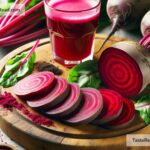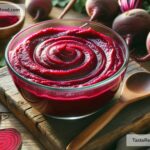Why Beets Are Known for Their Deep Red Color
Beets are often celebrated for their rich, deep red color. This vibrant hue makes them stand out among other vegetables and adds a pop of color to salads, juices, and dishes. But have you ever wondered why beets are red? Understanding the science and the benefits behind this can help you appreciate this humble root vegetable even more!
The Science Behind the Red Color
The deep red color of beets is due to a group of pigments called betalains. Betalains are unique to beets and a few other plants—unlike pigments found in carrots (like carotenoids) or leafy greens (like chlorophyll). The type of betalain responsible for the red color is called betacyanin. These pigments are water-soluble, meaning they dissolve in water, which is why beet juice stains surfaces so easily.
Betalains are not only responsible for the red color but also contribute to the purple or yellow tones in certain varieties of beets. For example, golden beets contain a different type of betalain called betaxanthin, which gives them their bright yellow or golden hue. However, red beets remain the most famous and widely consumed variety.
Why Beets Have Betalains
Plants develop pigments for several reasons. For beets, betalains play a role in protecting the plant. These pigments help shield the beet’s cells from oxidative stress caused by sun exposure and environmental factors. Oxidative stress happens when harmful molecules, called free radicals, damage cells. Betalains act as antioxidants, which neutralize these free radicals and reduce cell damage.
In addition to protecting the plant, the pigments attract pollinators and animals to carry seeds to new locations. The bright colors—whether red, purple, or yellow—are eye-catching, drawing insects or animals to interact with the plant.
Curiosity About Red Beet Stains
If you’ve ever cooked beets, you know that their deep red juice can stain your hands, clothes, and cooking utensils. The reason for this lies in betalains. Because betalains dissolve in water easily, the pigment can spread wherever it touches. Interestingly, eating beets can also leave a temporary red tint in your urine or stool. This harmless condition, called beeturia, varies by person and is influenced by how the body processes betalains.
The Health Benefits of Betalains
The vibrant red color isn’t just beautiful to look at—it holds powerful health benefits too! Betalains are antioxidants, which means they help protect your body from damage caused by oxidative stress. Oxidative stress is linked to aging, inflammation, and diseases like cancer and heart disease. By consuming foods rich in antioxidants like beets, you can support your overall health and well-being.
Betalains may also help reduce inflammation in the body. Inflammation is your body’s natural response to injury or infection, but chronic inflammation can lead to serious health problems over time. Eating beets has been shown to improve inflammatory markers in some studies, making them a great addition to an anti-inflammatory diet.
Moreover, betalains are believed to support liver health by promoting detoxification processes in the body. This makes beets an excellent food choice for anyone looking to cleanse or promote a healthy lifestyle.
Red Beets in History and Culture
The deep red color of beets has intrigued people for centuries. Originally cultivated in the Mediterranean region, beets were used not just as food but also as medicine. Ancient civilizations recognized their ability to support digestion and general health.
In some cultures, beet juice has been used as a natural dye to color fabrics or foods. Even today, beet extract is often included in food products as a natural alternative to synthetic colorings. This is partly because betalains are safe to consume and don’t pose health risks like some artificial dyes.
Beets are also a popular ingredient in traditional dishes worldwide. From borscht, the famous beet soup of Eastern Europe, to pickled beets in the United States, people have long celebrated their deep red color and earthy flavor.
How to Enjoy Red Beets
There are many ways to enjoy the beauty and benefits of red beets. You can roast them for a sweet, caramelized flavor, blend them into smoothies for added nutrition, or slice them thinly and add them to fresh salads. You can even use beet juice to naturally color cakes, cookies, and frostings.
For maximum health benefits, try eating beets raw or lightly cooked. Overcooking can reduce the potency of betalains and other nutrients. Pair them with citrus or other fresh flavors to balance their earthiness.
Final Thoughts
The deep red color of beets, created by betalains like betacyanin, is one of nature’s wonders. These pigments not only make beets beautiful but also provide incredible health benefits. From their role as antioxidants to their cultural significance throughout history, beets are a vegetable worth appreciating.
So, next time you see a fresh bunch of red beets at the store or farmers market, be sure to grab some! Their vibrant color is just the beginning of what they have to offer. And if you happen to stain your hands while preparing them, don’t worry—it’s just a colorful reminder of how amazing beets truly are.


